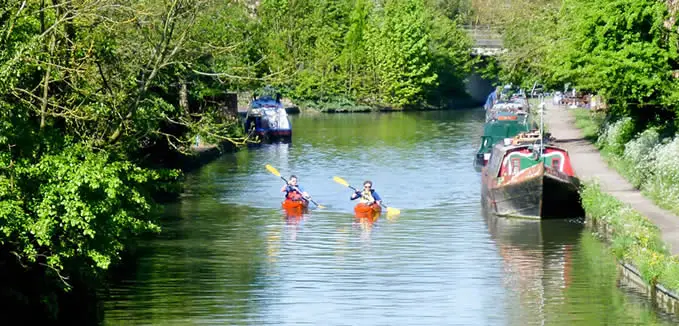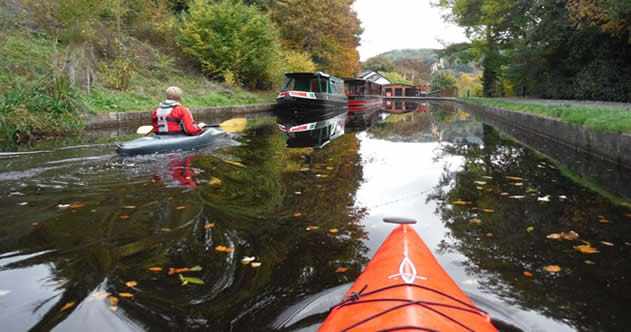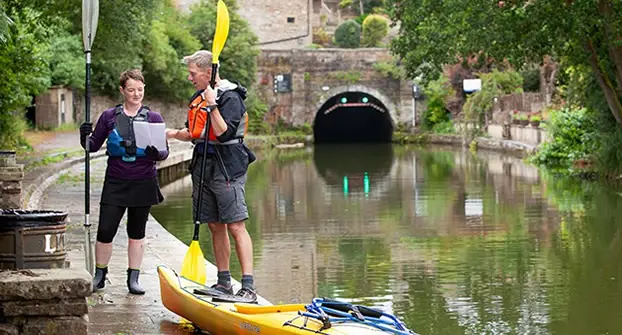Contents
- Advice For Kayaking On Canals
- First things first – can you kayak on canals legally & safely?
- The best type of kayak for canal use
- Why canals are ideal for kayaks
- Some examples of the best canals to kayak on in the US, Canada & UK
- Why kayaking is the ideal way to explore canal networks
- Permit and license requirements for canal kayaking
- Keeping safe when kayaking on a canals
- The ideal gear you need for canal kayaking
- Resources to find out more about canal kayaking
Advice For Kayaking On Canals
Many people are unaware that you can safely and legally kayaking on canals and if you love to take to the water in a kayak then I highly advise you to try this.
With canal kayaking you can paddle unique waterways that span both urban and rural landscapes for the best of both worlds.
Below I have included helpful advice on the following subjects:
- The best kayak for canals.
- The best way to explore a canal system in a kayak.
- Permit requirements for canal kayaking.
- How to stay safe while kayaking on canals.
- The ideal kayaking gear you need.
First things first – can you kayak on canals legally & safely?
It is perfectly legal and safe to kayak on canals as long as you take some simple safety precautions.
Be aware that some countries and states have individual permit and license requirements for kayaking on their canal network.
In most cases the money gained from these is used for the upkeep of the canal network.
The best type of kayak for canal use
What is the best kayak for a canal?
The best kayak for a canal is a flat-bottomed recreational kayak because it offers exceptional stability on calm canal water.
A flat-bottomed recreational kayak is also easy to paddle and maneuver in the calm water of a canal.
Because kayaks are small boats they tend to be at the mercy of choppy water and challenging weather much more than other boat types – with some notable exceptions of course.
For this reason calm waterways, like those found in canals, offer a more relaxed kayaking experience.

Although there are seaworthy kayaks that are perfect for open waters, and river kayaks that can ride rapids, arguably the most common type of kayak on the water is the recreational kayak.
With a flat-bottom hull and straight sides a recreational kayak is a perfect single-person boat for day tripping and short excursions on calm water.
Recreational kayaks are perfect for canal use as they offer exceptional stability and ease of use in that type of environment.
There are additional benefits offered by this type of kayak that are too numerous to go into in this article but which we covered in detail here.
Why canals are ideal for kayaks
Canals are ancient waterways that date back as far as 4000 BC. Although old they really only came into their own during the Industrial Revolution when a dependable transport network was required for the cheap transportation of resources and goods.
Two main driving forces behind the expansion of the canal network were the Duke of Bridgewater and an engineer called James Brindley.
Canals are man-made inland waterways that act like artificial rivers.
Canals were embraced as a water-based transportation network because they were an ideal way for moving very heavy freight up and down a country and across borders long before road transport was available and even before the railroads existed.
Originally, these channels were used solely for commercial purposes, with goods and freight being moved across regions on commercial barges, narrowboats and other types of appropriate vessels.
Because canals are man-made they tend to be fairly shallow and not very deep.
Therefore the boats that were designed for use on those waterways had to have a flat-bottomed hull with a shallow draft.
Because canals are not very deep and are well protected from strong winds they are almost always very calm.
As a commercial transportation network canals were phased out as rail and road transport eventually took over.
Although some canals remained open, and were used for a variety of boating needs, most fell into disrepair.
Only in recent decades have recreational enthusiasts helped to resurrect canal networks in many different countries.
Reopened networks have seen modern canals transition from working transportation networks to recreational boating areas that offer breathtaking views of areas of natural beauty and easy access to historical sites and bustling towns.
Because canals tend to be very shallow (and very narrow in some countries, like the UK) special boats were designed for hauling freight on them.
Today these canal boats have morphed into mostly pleasure craft with many different types existing, from the large steamboats of the USA to the slim narrowboats of the British Isles.
We covered the different types of canal boats here.
Because canals are calm, shallow waterways they rarely experience even the slightest bit of choppy water.
A canal route will travel through towns regularly, regardless of the country it is in, meaning rests stops and cafes are never far away.
A canal offers a safe way to take to the water in a kayak. Canals move through countryside and urban areas.
One minute you will be in the open countryside and a few minutes later you could be in a bustling town.
Some examples of the best canals to kayak on in the US, Canada & UK
Beautiful canals can be found across the world and most embrace the industrial heartlands of major cities and towns as well as the expansive basins spanning country valleys.
This makes them perfect for day trips or boat camping in a kayak.
A kayak can used on any canal unless specifically prohibited.
You will be informed if a specific canal does not allow kayaks when you apply for a permit or license.

Here are some famous canals that you may want to explore by kayak:
Canals in the United States of America
Canals in Canada
Canals in the United Kingdom
Across Europe there are also an extensive network of canals that offer some truly stunning scenery and access to may historical sites.
If you are interested in kayaking on a canal as part of a long, or short, break then be sure to read our article 10 reasons to choose a canal vacation this year.
Although the aforementioned article is related to using a canal boat it applies equally as well to a using a kayak.
Why kayaking is the ideal way to explore canal networks
In countries like the UK recreational barges and narrowboats are the typical type water traffic that you will see on canals.
In Europe and North America goods are still transported via a number of working waterways but you will also find a variety of different types of recreational canal boats on the water too.
So, a little kayak may seem out of place amongst these larger and more distinctive vessels but more and more kayakers are discovering the enjoyment that navigating canals offers.
So you will certainly not be alone when you kayak on canals in your country.
Here are some key benefits from canal kayaking:
- Canals and inland waterways are really opening up to a wider range of watercraft. That means that kayakers are now being increasingly recognized, welcomed and encouraged to use canals alongside the larger, more traditional, vessels.
- Opportunity to get on the water close to home. Many people live near a canal, meaning kayakers can have great access to practice their pastime conveniently and with great accessibility.
- See the local area from a new perspective. Kayakers always get unrivaled access and proximity to their environments and with canals it is no different.
- Calm and relatively shallow water. Canals have been designed to provide a consistent calm environment. The canal dams and locks dotted along the channels mean that currents are kept to a minimum, making a canal great for beginner kayakers. The typical depth of a canal is very shallow. In Europe canal depth will range anywhere from 4 feet to 6 feet while some American canals can be as much as 7 feet deep. There are exceptions, such as the canals along the Intercoastal Waterway in the USA, which have a minimum depth of 12 feet, but they are rare and are usually only found in very commercially active waterways.
- Great trails that enable you to explore as much or as little as you want. Canals cover extensive regions but have easy exit points. This means that you can cover as much or as little distance as you want.
- Countryside and town access. Even though canals traverse some truly stunning and empty countryside when you travel on one you are never far away from an interesting spot such as a historical landmark or bustling town or even the old commercial heartland of a large city.
- Lots of “truck” stops. Because most canals have been revitalized and brought back to life by recreational enthusiasts there is no shortage of stopping points. Just like a highway has truck stops, canals have lots of rest points as well. Cafes, taverns and restaurants dart the canal landscape and camping sites are usually within a short walking distance of designated spots.
Permit and license requirements for canal kayaking
Licensing is required to kayak on a canal throughout most of the world. In fact you usually need a permit or license to use any publicly owned inland waterways.
In countries like the USA, Canada, and the UK, paddling registration fees go towards the upkeep of canals, rivers, ramps and slipways as well as other public access facilities.
Licensing organizations will ensure that you are educated on how to use a canal safely. They are also well versed in all the relevant local rules and bye-laws pertaining to the canals you plan to paddle on.
Having a permit is not just a good idea as it helps keep the canal network in good shape but because it also lets people know you are using the waterway it promotes awareness of kayaking amongst other water users.
Keeping safe when kayaking on a canals
Canal kayaking has lots of benefits and is one of the safest forms of paddling. But, it is important to understand that like all water based boating activities, there are some risks and dangers involved.
Below are a few tips to help keep you safe while paddling on a canal
- It is important to remember that canals can be very busy environments, with recreational boaters and even working vessels going about their own business. These larger vessels can create wash and wake that will disturb your kayak.
- Visibility is important as you will be closer to the water than other canal users and in narrow canal channels, that are busy, you may be very easy to miss. Kayaking in a group is always the safest option as groups are easier to see.
- Canals often have variable depth, and clearing the canals of debris is an ongoing project in many countries, so you could hit underwater obstructions if you capsize. So, a helmet and proper safety equipment is advised.
- Likewise, the water may not be that deep but you still need a quality PFD.
- Locks and dams can be hazardous for kayakers and you are not required to use them. You should not attempt to directly traverse them if that is an option but rather exit the canal and carry your kayak around the lock (portaging), reentering the water on the other side.
The ideal gear you need for canal kayaking
Your kayaking gear should not vary greatly from the equipment you use for other forms of kayaking – see our article on essential kayaking equipment here.
If you plan to use the kayak at night you are required to adhere to certain laws, such as having a navigational light, and you should take additional safety precautions – all of which we outlined in our guide to kayaking at night.

Below is a quick bullet point summary of the things you will need to kayak on a canal.
- Kayak – Obviously! Both sit-in and sit-on-top kayaks can be used, though it is more common to see sit-in kayaks on canals. We covered the difference between the two types here.
- Paddle. A standard lightweight paddle, and spare paddle, is all you need.
- Paddle leash. To recover a dropped paddle.
- Helmet. Most countries and states have laws making kayaking helmets mandatory.
- Life vest/Personal Floatation Device/Buoyancy aid. This is a non-negotiable piece of kit that could save your life. It’s a good idea to get a reflective PFD
so you are more visible on the water.
- Whistle. This is another mandatory piece of kit. It’s illegal to paddle without one. Get a plastic one as a metal one will erode and eventually stop working.
- High visibility vest. If your PFD is not fluorescent or reflective. The addition of a vest will give you more pockets.
- Drysuit/Wetsuit. A wetsuit
is designed to keep you warm if you fall into cold water. It is worn next to the skin. and usually only needed in colder months. A drysuit
is worn over your clothes and is completely waterproof and probably the better option for canal kayaking.
- Spray skirt. A spray skirt, also called a spray deck, is not totally necessary as canal waters are very calm but using one will ensure your lower half stays dry 100% of time no matter what happens.
- Map. Most canal networks will have some sort of map near the banks at spaced intervals but it is still a good idea to carry your own more detailed map of the canal and the surrounding areas so you can explore and/or plan your trip.
Be sure to check our essential kayak gear and equipment article for a full list of the items you will need.
Resources to find out more about canal kayaking
In the UK and North America there are a number of agencies and organizations that oversee activities like kayaking on inland waterways.
Browse the links below to learn more about how you can get started, licensing requirements and to find some popular locations.
USA
The Erie Canalway, New York.
Lake Washington Ship Canal, Seattle.
UK
Regent’s Canal, London.

